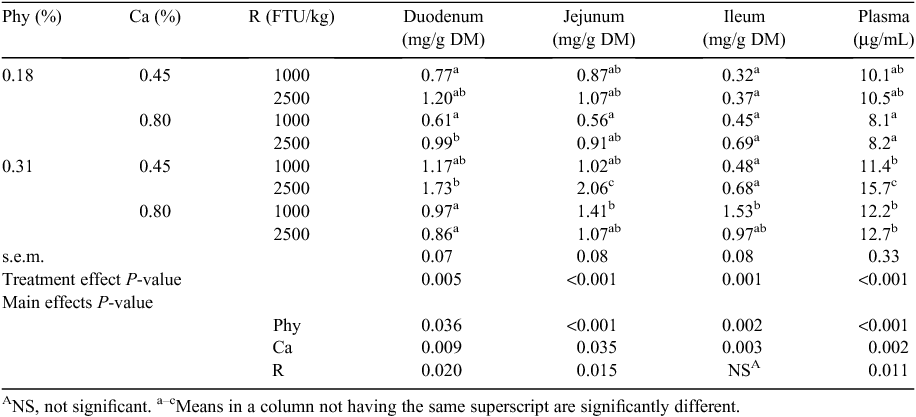Dietary phytate, calcium and phytase levels affect the small intestine and plasma myo-inositol concentrations in weaned pigs
P. Guggenbuhl A B , R. Aureli A and E. Perez Calvo AA DSM Nutritional Products SA, Saint-Louis, France.
B Corresponding author. Email: patrick.guggenbuhl@dsm.com
Animal Production Science 57(12) 2429-2429 https://doi.org/10.1071/ANv57n12Ab089
Published: 20 November 2017
Dietary phytase, has the potential to degrade phytate to the myo-inositol (INO) ring increasing plasma INO concentration (Cowieson et al. 2015; Guggenbuhl et al. 2016). The aim of this study was to evaluate the INO concentrations in the small intestine content and plasma in weaned pigs fed diets with different levels of phytate (phy), calcium (Ca) and phytase (C. braakii; Ronozyme HiPhos, DSM). The hypothesis tested was that the phytase (R) inclusion levels would modulate the INO production in the presence of high dietary levels of phy and Ca.
An experiment was conducted with 128 28-day-old castrated male weaned pigs (Large White × Redon) having an initial bodyweight of 7.2 ± 1.2 kg (mean ± s.e.). Pigs were randomly allotted into eight treatment groups of 16 animals each (four pens of four piglets). They were fed ad libitum for 42 days with mash diets based on corn, soybean meal and rapeseed meal. Eight diets were formulated to meet the animal requirements for weaned pigs according to NRC (2012) (crude protein (CP), 198 g/kg; metabolisable energy (ME), 13.0 MJ/kg; total P, 0.47%; total lysine, 1.40%). The experiment was conducted in a 2 × 2 × 2 factorial design with two dietary phy (0.18 and 0.31%), Ca (0.45 and 0.80%) and R (1000 and 2500 FTU/kg) concentrations. Myo-inositol concentration of digesta from the small intestine segments and plasma were determined at the end of the trial (Leung et al. 2011). Data were analysed as a 2 × 2 × 2 factorial ANOVA and differences between groups were determined by the Student–Newman–Keuls multiple-range test (significant at P ≤ 0.05) (StatGraphics Centurion XVII, Manugistics, Rockville, MD, USA).
In all four compartments, the 0.31% phy level gave a higher (P < 0.05) INO concentration than the 0.18% phy level (Table 1). By contrast, the INO concentration was lower (P < 0.05) with the 0.80% Ca level than with the 0.45% Ca level. A higher INO concentration was measured in the duodenum, jejunum, and plasma with the highest dietary R inclusion of 2500 FTU/kg.

|
Myo-inositol is the end product of phytate degradation and requires joint action of dietary phytase and endogenous phosphatases. In the duodenum, jejunum and plasma, INO concentration was increased by the higher levels of phy and R, indicating more phytate degradation. In the ileum, the lower INO levels and the lack of the R effects could be explained by an early absorption in the jejunum. Calcium significantly reduced the overall impact of R on INO production. This was particularly verified in plasma and duodenum where INO levels were low when Ca inclusion was high and phy inclusion low. Data from the present study showed that R could modulate INO concentration in the duodenum, jejunum and plasma in weaned pigs fed diets containing low Ca and high phy concentrations.
References
Cowieson AJ, Aureli R, Guggenbuhl P, Fru-Nji F (2015) Animal Production Science 55, 710–719.| Crossref | GoogleScholarGoogle Scholar |
Guggenbuhl P, Perez Calvo E, Fru F (2016) Journal of Animal Science 94, 243–245.
| Crossref | GoogleScholarGoogle Scholar |
Leung KY, Mills K, Burren KA, Copp AJ, Greene ND (2011) Journal of Chromatography. A 879, 2759–2763.
NRC (2012) ‘Nutrient requirements of swine.’ 12th edn. (National Academy Press: Washington, DC)


